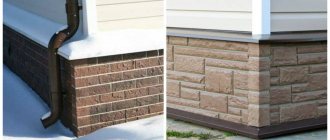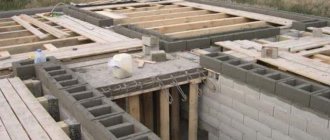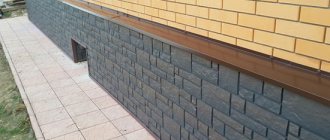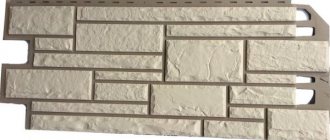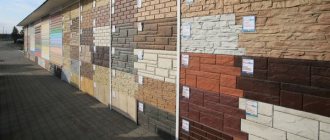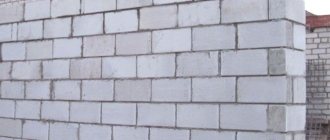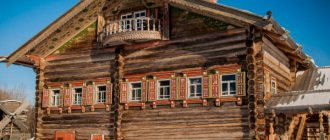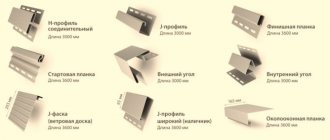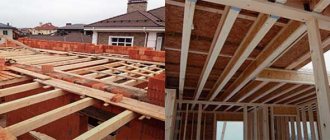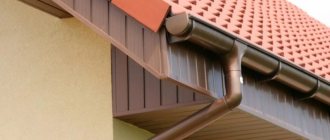Owners of country houses one day think about how and with what to cover their building so that it is protected from external influences and at the same time looks quite attractive.
The construction market offers a large selection of building materials for finishing, but not everyone is suitable for an old house or one built from light building materials. Country siding is well suited for covering a small house and getting an excellent result.
Variety of this material
It is important to understand that different types of the same finish may differ in certain characteristics. This means that one option is suitable for a house with a long service life, while the other is better to choose for a recently erected and reliable structure. Let's look at different types of siding:
- Metal. Made from galvanized steel or aluminum. The cladding has excellent strength properties and perfectly protects against mechanical, biological and atmospheric influences. But not every house can withstand the weight of such cladding. It is better to choose it for houses made of bricks or blocks.
- Fiber cement panels. High quality cement and cellulose fibers are used as raw materials. The result is siding that is durable and reliable. But in terms of price, this option is more expensive, and also has a lot of weight and is unlikely to be suitable for frame summer houses.
- Wood siding. This type of finish is made from natural wood with the addition of synthetic resins, which makes it more resistant to the external environment. But we must also take into account the fact that wood, even protected by certain compounds, is an extremely impractical material. After some time, it loses its attractiveness, and then you have to spend time and a day updating the facade.
- Vinyl panels. This option is ideal for covering a country house with siding. The finishing is light and reliable and at the same time the price is quite affordable. True, you will have to be careful not to damage it with garden tools. But the lower areas of the house can be finished with basement vinyl siding. Manufacturers made it specially much stronger.
What materials and tools will be required?
To carry out cladding work you will not need as many tools as you might think. Usually they are found in every home, which is why vinyl siding is considered so simple. To install it you will need the following:
- hammer;
- a stepladder, the height of which should be sufficient to easily carry out work at the highest point of the house;
- grinder, a saw with small teeth is also suitable;
- screwdriver;
- screwdriver;
- roulette. The best option would be to have a laser tape measure, as it will make installation much easier.
Very often, siding manufacturers, when purchasing material, offer a full set of components that will be required for installation. Such kits include panels and everything necessary for finishing a house, even with a complex structure. In order to receive such a set, you need to provide the seller with information about the area of the house, the number of windows and other parameters. This will allow you to choose the right material that is ideal for the house that is to be covered. But when placing an order, it is recommended to double-check the material’s compliance with the requirements and take into account the construction features.
To cover the house you will need external and internal corners. The outside corner plays an important role in the design of the sheathing. It performs a decorative function, covering the ends of the siding. It is also necessary to make the cladding more durable. The height of the outer corner is 3 meters. When covering a one-story house, this length is usually sufficient. If the house is more than 3 meters high, then a calculation is performed.
Internal corners are intended for covering the junction of the wall and the roof. Also, when selecting material, you need to pay attention to the window trim. This element must be purchased in excess to hide the joint. In addition, it is worth remembering that elements for window decoration should not have joints that will be noticeable.
When installing siding, it is recommended to use self-tapping screws made of zinc-coated steel. On average their length is 25 mm. The use of such self-tapping screws will allow you to maintain the gap between the siding. In order to avoid the appearance of rusty stains in the future, you need to use self-tapping screws with a rubber head.
Advantages of vinyl siding
This material has a number of advantages that set it apart from other types of this finish.
- Ease. Allows you to transport and move elements without much difficulty. In addition, it can be installed both on new buildings and on old ones.
- Protective functions. Vinyl siding perfectly resists temperature fluctuations, humid environments, and the effects of microorganisms.
- Wide selection of colors and textures.
- Affordable price.
- Unpretentious care. For cleaning use ordinary water. More serious stains can be removed with a sponge and detergent. But ordinary melt or rain water can easily remove dust.
- Long service life. Some manufacturers indicate a figure of about 50 years. But be careful when choosing colors. Often, to reduce the cost, low-quality dyes are chosen, and bright colors lose their attractiveness after the first sunny season. Therefore, it is better to choose pastel shades.
The best color combinations on the facade
1. White color is universal.
It will give the house volume and make it visually larger. Will match with plinth and roof of any color. Moreover, the darker the corners and the lower part of the facade, the more neat and chiseled the house will appear. Another plus of white: even the most budget siding will not fade in the sun.
White siding is a win-win option (photo No. 11)
2. Beige color is associated with natural materials.
Such a house seems more environmentally friendly. You can match it with almost any shade - blue, green, brown, light blue.
Combination of natural shades (photo No. 12)
3. Yellow color is life-affirming and optimistic.
It will look good with blue and purple, green, orange, brown.
Yellow color adds sunshine even in winter. (photo No. 12)
4. Brown color visually makes the facade warm and neat.
Add light shades to it - white, beige, pink, blue, light green.
Brown siding looks like wood. (photo No. 13)
5. Green looks good against the sky.
On the facade it can be shaded with brown, chocolate, beige, and other shades of green.
The green façade is in harmony with the nature of the site (photo No. 14)
6. Cream – stylish and discreet.
Pairs well with other soft shades: beige, brown, light green.
Noble cream facade (photo No. 15)
7. Blue is the color of the sky.
By itself it looks quite bright, so it will go well with dark shades - brown, chocolate, cherry or dark blue. Of the light shades, beige and light green will look good with blue.
A blue façade is an excellent choice for a country house. (photo No. 16)
8. Pink color is chosen for small country houses.
It looks good against any background - trees, sky, neighbors' houses. Combines with blue, dark blue, chocolate, green.
9. Burgundy color, although similar to brown, looks richer and more saturated.
You can choose white, beige or light green panels for it.
The burgundy façade is active and cheerful (photo No. 17)
10. Gray color will give the house a slightly cold, unapproachable look.
Panels from the same color scheme (darker or lighter), as well as cherry, will suit it.
Combination of shades of gray on the facade (photo No. 18)
Finish options
Finishing a country house with siding can be done in several ways:
- Horizontal cladding. Use horizontal panels.
- Vertical cladding. This is done using vertical siding.
- Decoration of the entire façade area with a basement view.
- Various combinations. It all depends on the imagination and tastes of the owner. You can combine horizontal and vertical, basement with horizontal or vertical siding. You can also add other types of finishing materials (natural or artificial stone, facade tiles, plaster).
Preparatory stage
Let's start by calculating the necessary materials and purchasing them. Typically, manufacturers produce panels with a length of 2.5 to 6 m and a width of 22–27 cm. Knowing the length and height of the walls of the building, you can calculate how many parts are needed. You must not forget about the additional elements (starting and finishing strips, corner elements, connecting strip, if necessary).
You need to buy with a margin of 10–15%. This amount will be enough to cover damaged elements during installation or transportation. It is also advisable to buy everything from one batch from one manufacturer. The dimensions of the parts and even the shade may differ in different batches, and even more so among manufacturers.
After everything has been purchased, you need to start preparing the foundation:
- Remove all incoming parts - waste pipes, antennas, fasteners.
- Clean the surface from old decorative coating.
- Remove stains and traces of fungi or insects.
- Treat the walls with deep penetration soil. This stage should not be skipped, since the composition will help protect the base from moisture and fungus, and therefore help maintain a pleasant indoor microclimate.
Finishing a country house with siding: what you need to know
When purchasing this material, do not forget about the presence of the required elements. These include: internal and external corners, hinged, initial and finishing strips, platbands, connection strips and edgings, j-chamfer and other parts. Make sure that the order the seller creates for you contains everything you need, otherwise you will have to travel tens of kilometers in order to purchase the necessary parts. The same applies to the amount of siding, which should be taken with a slight excess - 10% more than calculated.
Work order
- First of all, you need to prepare the wall itself. All protruding parts, such as window and door frames, hooks and hanging structures, are dismantled. In this case, poorly secured parts are strengthened or removed. If there are gaps and cracks, it is better to seal them with cement mortar. Wooden walls are treated with antiseptic and fireproof impregnations. Finally, we ensure that the surface is clean and free of traces of fungi;
- The lathing structure is installed. As a rule, this is done using boards, which we also pre-treat with antiseptics and attach to the walls using dowel joints. If necessary, a layer of insulation is attached to the space between the boards;
- The starting strip is attached, after which the first row of siding is mounted on it. The upper part of the element is secured with self-tapping screws in the sheathing. The next rows are fastened so that the bolt heads of the bottom row are covered. The materials should be connected in a checkerboard pattern to ensure maximum tightness.
Important! Covering a house with siding, as a rule, begins from its rear.
Frame construction
Before installing the frame on which the siding panels will be attached, you can attach insulation. Additional thermal insulation will make the country house warmer in the cold season, and in the hot season it will keep it cool.
To secure the insulating material you need:
- Cover with vapor barrier film. The joints must be taped with tape.
- Attach insulation. You can use the one you like best based on its technical characteristics.
- Cover with another layer of vapor barrier film. Protects the insulating material from evaporation from the interior, moisture and cold gusts of wind from the external environment.
Now let's move on to the frame. For horizontal siding, a vertical sheathing is installed; for vertical siding, a horizontal version is installed. The distance between elements should not exceed 50 cm.
How to choose components for siding?
The choice of accessories is determined by the finishing material used, as well as the configuration of the building.
If the components do not fit the siding, the strips will have to be cut. This will complicate the process of finishing the house. Therefore, it is better to choose components that match the size of the panels. The best option is to purchase a complete set from one manufacturer. This is a guarantee that all elements will fit together flawlessly. In addition, specialists in the company store will help you perform the correct calculation of siding and components. This means you don’t have to figure out where to put the leftovers or urgently look for missing components in the nearest market.
Siding installation
There is a specific plan according to which this cladding is installed. Even a beginner can cope with this task.
- Securing the starting bar.
- Installation of corner elements.
- Fastening the first panel. The bottom edge is placed in the starting strip, the sides are installed in the corner pieces. On the top side there are holes for fasteners; you need to place and fix a screw or nail in them. Do not tighten the fasteners all the way. After installation, the part should be movable by 2–3 mm in both directions.
- Installation of all subsequent panels.
- Fastening the finishing strip.
Video installation instructions
The technology of covering with vinyl or acrylic siding is described in detail in this video. We are talking about how and in what order to install profiles, how to mount and join external and internal corners. The process of covering a window with siding is described in detail.
Installation of facade siding is not much different. Is it just because the sheathing is required “in a cage”. Otherwise, everything is the same: we install the screws in the center of the mounting holes, do not tighten them.
This is what the sheathing looks like for basement siding (under stone, brick or tile)
There are small peculiarities in the joining of elements. There are stops on the back of the panels that prevent the panel from moving further. When installing siding under stone or brick, you must not miss this point: the stops may break under strong pressure. The features of installation are well described in the advertising and training video of the German manufacturer Docke (Dock or Deck).
To see how a large wooden house was covered with vinyl siding to look like stone, see the following video. This is no longer a commercial, but an experience: laying siding with your own hands was done for the first time. What happened and what the sensations are - look.
